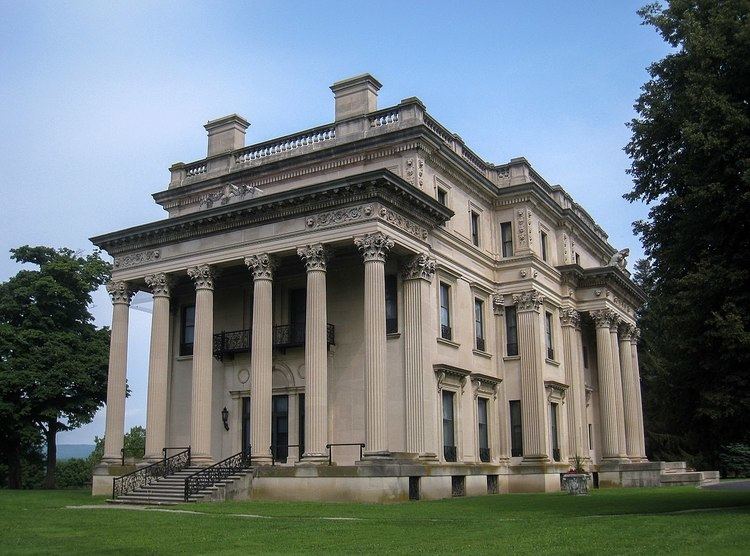Architect McKim, Mead & White Visitation 372,517 (2005) Phone +1 845-229-7770 Added to NRHP 15 October 1966 | Built 1896–99 Area 85 ha Established December 18, 1940 | |
 | ||
Website Vanderbilt Mansion National Historic Site Address 119 Vanderbilt Park Rd, Hyde Park, NY 12538, USA Hours Open today · 9AM–5PMSaturday9AM–5PMSunday9AM–5PMMonday9AM–5PMTuesday9AM–5PMWednesday9AM–5PMThursday9AM–5PMFriday9AM–5PMSuggest an edit Similar Home of Franklin D Roosevel, Eleanor Roosevelt National, Top Cottage, Franklin D Roosevelt President, Staatsburgh State Historic S Profiles | ||
Destinations vanderbilt mansion national historic site
The Vanderbilt Mansion National Historic Site is a historic house museum in Hyde Park, New York. It became a National Historic Landmark and started operation under the National Park Service in 1940. The mansion, known as Hyde Park, was the Gilded Age home of Frederick William Vanderbilt and his family from 1895 to 1938.
Contents
- Destinations vanderbilt mansion national historic site
- Hyde park new york vanderbilt mansion national historic site hd 2016
- History
- Mansion
- Gardens
- References
The 54-room Vanderbilt mansion was designed by the architectural firm McKim, Mead & White. Designed and built between 1896 and 1899, the house is an example of the Beaux-Arts architecture style. The interior of the mansion is an archetype of the American Renaissance, incorporating European antiques and intricate period reproductions. The site includes 211 acres (85 ha) of the original larger property, including lawns against the Hudson River, formal gardens, woodlands, and auxiliary buildings. The grounds also include Italian gardens that were restored by the volunteer Frederick W. Vanderbilt Garden Association.
Hyde park new york vanderbilt mansion national historic site hd 2016
History
Known as Hyde Park, the Vanderbilt site is one of the area's oldest Hudson River estates. The earliest development of the estate began in 1764 when Dr. John Bard purchased land on the east side of the Albany Post Road, where he built Red House and developed the agricultural aspects of the eastern section of the property that continued through Frederick and Louise Vanderbilt's occupancy. Bard family ownership continued through 1821 with his son, Dr. Samuel Bard (1742–1821), owning the property from 1799 to 1821. In 1828, Dr. David Hosack, president of the New York Horticultural Society, purchased the property from Samuel Bard's heirs, with André Parmentier helping to design the grounds. In 1840, John Jacob Astor purchased the property from Hosack's heirs for his daughter Dorothea and her husband Walter S. Langdon.
Frederick and Louise Vanderbilt purchased Hyde Park in May 1895 from Langdon's heirs. Attracted to the Hudson Valley and the land on the east bank of the Hudson River, Frederick and his wife settled into their 600-acre (240 ha) estate. The location offered quick and easy access to New York City on the Vanderbilt's own New York Central Railroad. The house was designed and built between 1896–1899, and was primarily used as a vacation home for Frederick Vanderbilt's family. The previous owners of the estate had made it well known for its grand landscape and array of different plants and trees throughout the property. The New York Times described the Vanderbilt’s estate as "the finest place on the Hudson between New York and Albany."
Their niece, Margaret "Daisy" Van Alen, inherited the property when Frederick Vanderbilt died in 1938. Encouraged by President Franklin D. Roosevelt (who owned an estate nearby), Van Alen donated a portion of the estate, including the residence with most of its original furnishings, to the National Park Service in 1940. From 1941 to 1943, Roosevelt's Secret Service was housed in the basement and third-floor service areas, and some of the President's personal White House staff and friends occasionally stayed in the main bedrooms of the house, including those of Frederick and Louise Vanderbilt.
Mansion
The 54-room mansion is the work of the architectural firm McKim, Mead & White. Charles Follen McKim designed the plan in the Beaux-Arts style and Stanford White assisted as an antiques buyer.
The house has a classic Beaux-Arts plan, with the major public rooms on its ground floor – the central Elliptical Hall, Dining Room, and Living Room – all in one line, parallel to the Hudson River. North and South Foyers provide transitional space from the Hall to the Dining Room and Living Room. Five secondary spaces are located off the Elliptical Hall: the Lobby, Den, Gold Room, Grand Stair Hall, and Lavatory. The second floor rooms, comprising Mrs. Vanderbilt's suite of Bedroom, Boudoir and Bathroom (designed by Ogden Codman), Mr. Vanderbilt's Bedroom and Bathroom, Guest Bedrooms and Baths and the Linen Room, are disposed around the Second Floor Hall and the North and South Foyers. The third floor contains five additional guest bedrooms, and a Servants' Hall separated from the guests' rooms by a door at the main staircase. Supported by both concrete and steel, the Vanderbilt mansion was considered modern for its time. The mansion also included plumbing and forced hot air central heating and electric lighting which was powered by a hydroelectric plant built on the estate on the Crumb Elbow stream. The Vanderbilt estate had electric lighting before the surrounding area.
Herter Brothers and A. H. Davenport and Company were subcontractors who executed McKim's interior designs. The Vanderbilts also hired Georges Glaenzer and Ogden Codman to decorate several rooms. E.F. Caldwell & Co. manufactured the majority of the lighting.
Gardens
Frederick's interest in horticulture caused him to develop several large gardens on the Vanderbilt estate. These lavish gardens incorporated the formal Italian style. This meant that the beds were arranged in such a way that if you drew a line across the middle, either horizontally or vertically, one side of the line would mirror the other side. These formal gardens also consisted of multiple tiers, which depended on the type of plants. Each level was different. Frederick himself added the rose garden which contained almost 2000 vintage rose bushes along with other kinds of roses.
